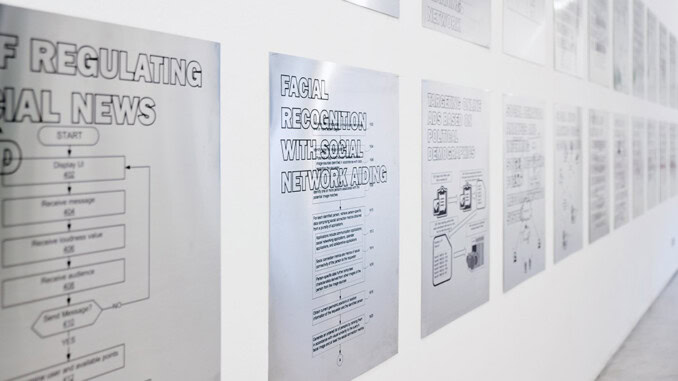
The Glorya Kaufman Community Center saw a crowd on Saturday, May 17, 2025, listening to artist Paolo Cirio discuss his work in ‘hacktivism.’ He defined this as using the data on the internet to get people to reflect on how data is used, with a number of compelling examples.
Originally from Italy, but now based in the U.S., Cirio has been using the internet since it’s very early availability to pull data off of websites and use it as another artist might use clay or paint to illustrate a point.
In Street Ghosts, he took images from Google Street Maps of people who had been photographed while walking or standing on a street while the data was being collected, and printed out a photo of them, gluing it to the wall where they were pictured – creating an artwork that reflected a momentary reality by making it fixed.
Sociality, another work, documented over twenty-thousand patents of socially manipulative information technology. Cirio collected and rated Internet inventions submitted to the U.S. patent office, and then he invited the public to share, flag, and ban the technologies designed to monitor and manipulate social behaviors.
The patent images and data were obtained by Cirio through hacking the Google Patents search engine. Then he rated the patents and created thousands of compositions with images of flowcharts and titles of inventions, which were published on the project’s website, Sociality.today.
The visual compositions on the website were printed in form of posters and a coloring book for informing on devices that enable discrimination, polarization, addiction, deception, and surveillance. The concept of turning patents into vehicles for regulation aims to exploit intellectual property law as a tool for democratic oversight.
As part of his installation Overexposed, now on display at the Wende as part of the current exhibit, are unauthorized photos of high-ranking U.S. intelligence officials who were related to Edward Snowden’s revelations. The appropriated material was found by monitoring photos and selfies published on Internet public platforms without the control of the officials.
The images were reproduced with the street art HD Stencils technique, and they were disseminated onto public walls throughout major cities. The artwork satirizes the era of ubiquitous surveillance and overly-mediated political personas by exposing the officials accountable for secretive mass surveillance and over-classified intelligence programs.
Cirio noted the success of some of the campaigns related to his work, such as the ban against the use of facial recognition technology in France, and the he is continuing to work on banning the technology in Europe.
Judith Martin-Straw
